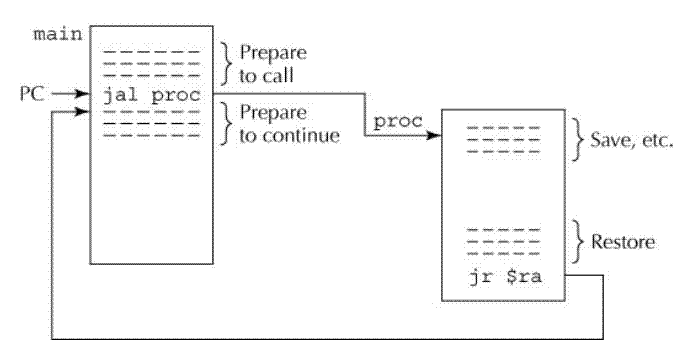CS201 Lab: SPIM Procedure Calls
In CS110, you have learned how to write user defined functions using C++.
In CS201, you can define similar functions using SPIM.
This lab focuses on implementing procedure/function calls in SPIM.
Procedure Calls
In this section, we are going to examine the code used to implement procedure and function calls. Procedures are the most important technique for structuring programs.
In C++, a function is called by its name with required arguments. When a function is called, the system will execute the function. When the function is finished, it returns a value to the calling function and the execution continues from the next statement right after the function call.
In SPIM, a function/procedure can be called by the code/control of jal functionname/procedurename. The code/control jr $ra can be used at the end of a procedure to return the control back to the statement right after the function/procedure call. When jal functionname/procedurename is executed, $ra is used to hold the return address (PC+4).
The following picture illustrates functions implemented in SPIM.

Passing Parameters
The first four parameters of a procedure are passed in argument registers $a0, $a1, $a2, $a3. Additional parameters are passed using the stack. $v0 and $v1 are used to store returned values. The following demonstrates procedure calls and passing and returning values from or to the calling function.
##
## Program name: sum.s
##
## The program will prompt the user to enter an integer N.
## A user defined function "sumup" will be called.
## The function "sumup" will calculate the sum of
## the integers from 1 to N (N will be passed to
## the function "sumup" in register $a0, and
## the sum will be returned in $v0).
##
## The program will print out the final result sum.
##
##
## $v0 - reads in an integer
## $t0 - holds the sum
## $a0 - points to strings to be printed
## - also used to pass N to "sumup"
##
#################################################
# #
# text segment #
# #
#################################################
.text
.globl __start
__start: # execution starts here
la $a0,prompt1 # print prompt on terminal
li $v0,4 # system call to print
syscall # out a string
li $v0,5 # syscall 5 reads an integer
syscall
move $a0, $v0 # copy the integer to $a0
jal sumup # procedure/function call
move $t0, $v0 # copy the sum to $t0
la $a0,ans1 # print string before the sum
li $v0,4
syscall
move $a0,$t0 # print the sum
li $v0,1
syscall
la $a0,endl # syscal to print out
li $v0,4 # a new line
syscall
li $v0,10 # exit
syscall # Bye!
############################################################
##
## The function "sumup" will calculate the sum of
## the integers from 1 to N (N will be passed to
## the function "sumup" in register $a0, and
## the sum will be returned in $v0).
##
############################################################
sumup:
move $v0, $0 # Initialize the sum to 0
#li $v0, 0 # OR initialize it this way
loop: add $v0, $v0, $a0 # $v0 = $v0 + $a0
addi $a0, $a0, -1 # $a0 = $a0 - 1
bnez $a0, loop # branch to loop if $a0 != 0
jr $ra # return to the calling function
#################################################
# #
# data segment #
# #
#################################################
.data
prompt1: .asciiz "Please enter an integer: "
ans1: .asciiz "The sum is "
endl: .asciiz "\n"
##
## end of file sum.s
Another example:
##
## The program --- Is-vowel.s will check if an entered character is a vowel.
##
## - It will ask the user for a letter (character),
##
## - then call a procedure ("vowelp") to check if it is a vowel.
## - It will return a value to the calling function,
## 0 means no, and 1 means yes,
## - and then print a message from the calling program.
##
## $v0 - used for syscalls
## - holds 0 or 1 after the call to "vowelp"
## $t0 - holds the returned value from the procedure call
## $a0 - points to strings to be printed
## - also used to pass a letter to "vowelp"
##
##
#################################################
# #
# text segment #
# #
#################################################
.text
.globl __start
__start: # execution starts here
la $a0,prompt1 # print prompt on terminal
li $v0,4 # system call to print
syscall # out a string
la $a0,letter
li $a1,5
li $v0, 8 # syscall 8 reads string/letter
syscall
la $s1, letter # prepare for passing a letter to the procedure
lb $a0,($s1)
jal vowelp # procedure call
move $t0,$v0 # save the value returned from the procedure call
beqz $t0, NotVowel
la $a0,ans1 # syscall to print out
li $v0,4 # the message - is vowel
syscall
j End
NotVowel:
la $a0,message # syscall to print out
li $v0,4 # the message - not vowel
syscall
End: la $a0,endl # syscall to print out
li $v0,4 # a new line
syscall
li $v0,10
syscall # Bye!
##############################################################
## Define the procedure vowelp
##############################################################
vowelp:
beq $a0,'a',yes
beq $a0,'A',yes
beq $a0,'e',yes
beq $a0,'E',yes
beq $a0,'i',yes
beq $a0,'I',yes
beq $a0,'o',yes
beq $a0,'O',yes
beq $a0,'u',yes
beq $a0,'U',yes
li $v0, 0 # assign 0 to $v0
jr $ra
yes: li $v0, 1 # assign 1 to $v0
jr $ra
#################################################
# #
# data segment #
# #
#################################################
.data
letter: .space 5
prompt1: .asciiz "Enter a character: "
message: .asciiz "The character entered is not a vowel."
ans1: .asciiz "The character entered is a vowel. "
endl: .asciiz "\n"
##
## end of file Is-vowel.s